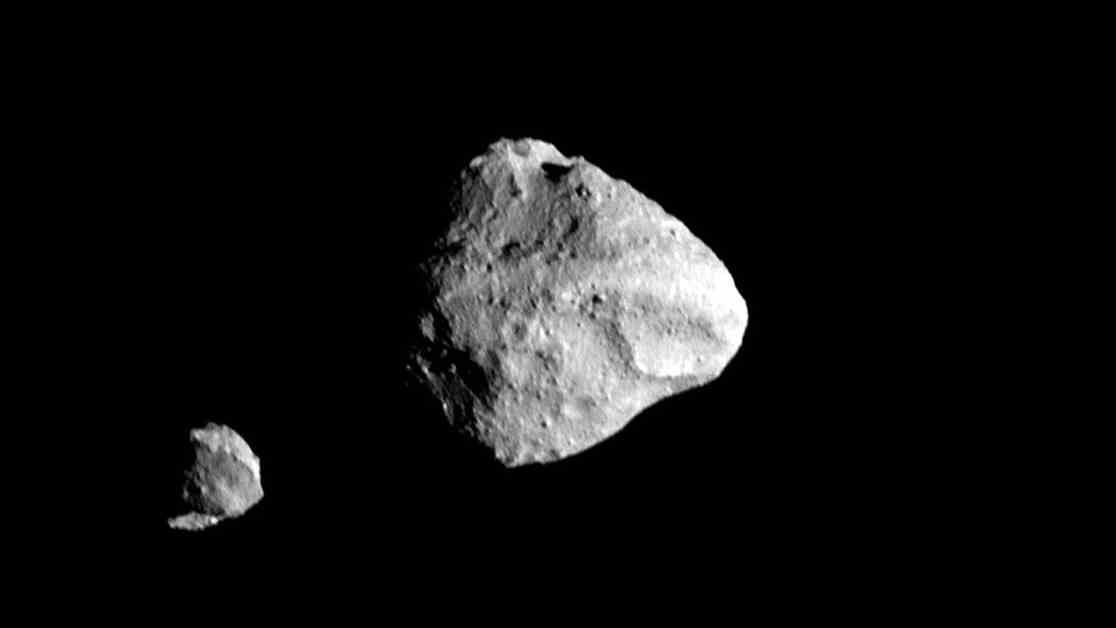NASA’s Lucy Reveals a Surprising Discovery on Asteroid Dinkinesh
NASA’s Lucy spacecraft recently made a groundbreaking discovery during its exploration of asteroid Dinkinesh. The mission not only unveiled the asteroid’s internal complexities but also revealed the formation of a double moon, Selam. This unique configuration, known as a contact binary, originated from debris orbiting Dinkinesh after a significant geological event.
In November 2023, NASA’s Lucy spacecraft conducted a flyby of asteroid Dinkinesh, capturing images that showcased the asteroid’s internal strength and complex history. The images displayed a trough, a ridge, and the presence of the contact binary satellite, Selam. These findings indicate that Dinkinesh underwent dynamic responses to stress over millions of years, providing valuable insights into the formation and evolution of small bodies within the solar system.
The images from the flyby revealed intriguing details, including a shifting piece of the asteroid, a ridge, and the formation of the contact binary satellite, Selam. These features suggest that both Dinkinesh and Selam possess significant internal strength and have experienced a complex, dynamic evolution.
NASA’s Lucy spacecraft captured stereographic image pairs of asteroid Dinkinesh during the flyby, highlighting the trough and ridge features. Additionally, a side view of Dinkinesh and its satellite Selam showcased the unique structural composition of the asteroid.
Researchers believe that Dinkinesh’s response to stress is indicative of its internal structure. The asteroid’s gradual increase in rotation speed, caused by thermal radiation from its surface, led to the formation of a more elongated shape and the eventual creation of the ridge and satellite, Selam.
The study of Dinkinesh’s structural features provides valuable insights into the asteroid’s historical evolution. The abrupt failure indicated by the trough and the formation of a disk of material during this event offer clues about how Dinkinesh and Selam evolved over time.
The researchers hypothesize that material from the disk contributed to the formation of the moon Selam, which consists of two objects in contact with each other, forming a contact binary configuration. The origins of this unique moon remain a topic of interest and further investigation.
Dinkinesh and Selam represent the first of 11 asteroids that NASA’s Lucy mission plans to explore over the course of its 12-year journey. Following a gravity assist from Earth in December 2024, Lucy will continue its mission to study various asteroids in the main asteroid belt and the Trojan asteroids.
The discoveries made by NASA’s Lucy spacecraft on asteroid Dinkinesh provide valuable insights into the formation and evolution of small bodies within the solar system. The mission’s findings shed light on the internal dynamics and historical development of asteroids, contributing to our understanding of planetary formation processes.
Reference:
“A contact binary satellite of the asteroid (152830) Dinkinesh” by Harold F. Levison, Simone Marchi, Keith S. Noll, John R. Spencer, Thomas S. Statler, James F. Bell III, Edward B. Bierhaus, Richard Binzel, William F. Bottke, Daniel Britt, Michael E. Brown, Marc W. Buie, Philip R. Christensen, Neil Dello Russo, Joshua P. Emery, William M. Grundy, Matthias Hahn, Victoria E. Hamilton, Carly Howett, Hannah Kaplan, Katherine Kretke, Tod R. Lauer, Claudia Manzoni, Raphael Marschall, Audrey C. Martin, Brian H. May, Stefano Mottola, Catherine B. Olkin, Martin Pätzold, Joel Wm. Parker, Simon Porter, Frank Preusker, Silvia Protopapa, Dennis C. Reuter, Stuart J. Robbins, Julien Salmon, Amy A. Simon, S. Alan Stern, Jessica M. Sunshine, Ian Wong, Harold A. Weaver, Coralie Adam, Shanti Ancheta, John Andrews, Saadat Anwar, Olivier S. Barnouin, Matthew Beasley, Kevin E. Berry, Emma Birath, Bryce Bolin, Mark Booco, Rich Burns, Pam Campbell, Russell Carpenter, Katherine Crombie, Mark Effertz, Emily Eifert, Caroline Ellis, Preston Faiks, Joel Fischetti, Paul Fleming, Kristen Francis, Ray Franco, Sandy Freund, Claire Gallagher, Jeroen Geeraert, Caden Gobat, Donovan Gorgas, Chris Granat, Sheila Gray, Patrick Haas, Ann Harch, Katie Hegedus, Chris Isabelle, Bill Jackson, Taylor Jacob, Sherry Jennings, David Kaufmann, Brian A. Keeney, Thomas Kennedy, Karl Lauffer, Erik Lessac-Chenen, Rob Leonard, Andrew Levine, Allen Lunsford, Tim Martin, Jim McAdams, Greg Mehall, Trevor Merkley, Graham Miller, Matthew Montanaro, Anna Montgomery, Graham Murphy, Maxwell Myers, Derek S. Nelson, Adriana Ocampo, Ryan Olds, John Y. Pelgrift, Trevor Perkins, Jon Pineau, Devin Poland, Vaishnavi Ramanan, Debi Rose, Eric Sahr, Owen Short, Ishita Solanki, Dale Stanbridge, Brian Sutter, Zachary Talpas, Howard Taylor, Bo Treiu, Nate Vermeer, Michael Vincent, Mike Wallace, Gerald Weigle, Daniel R. Wibben, Zach Wiens, John P. Wilson and Yifan Zhao, 29 May 2024, Nature. DOI: 10.1038/s41586-024-07378-0
Lucy’s principal investigator is based out of the Boulder, Colorado, branch of Southwest Research Institute, with mission management provided by NASA’s Goddard Space Flight Center in Greenbelt, Maryland. Lockheed Martin Space in Littleton, Colorado, is responsible for building and operating the spacecraft, with NASA’s Marshall Space Flight Center in Huntsville, Alabama, overseeing the Discovery Program.




